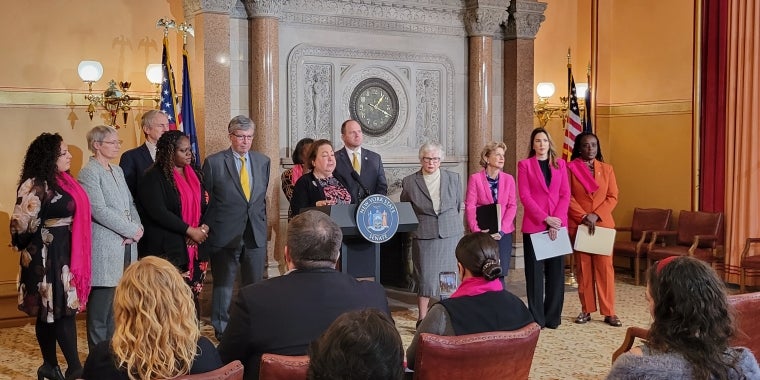
Rents Through The Roof?
Thousands of East Siders could see their rent double or triple if rent regulation expires
By Megan Finnegan
New York City already has a notoriously high cost of living, but if current rent-regulation laws expire June 15, tens of thousands of Upper East Siders may face astronomical increases in their rents that could push them to the outer boroughs or even out of the state.
While many tenant advocates say it’s unlikely lawmakers will let this happen, they and other Democrats are pushing for a rent-reform package that will not only renew but also strengthen current laws, and hope that it passes as part of Governor Cuomo’s budget package.
Advocates for rent reform want to make it harder for landlords to bring apartments into market rate, citing increasing costs of living in New York and the decreasing availability of rent-stabilized apartments.
Caroline Winston is part of the East Side Housing Coalition, which recently joined forces with the Metropolitan Council on Housing, and has been on the steering committee of the Real Rent Reform Campaign for the past nine months. She’s been pushing rent reform for years, and led the charge against her building’s landlord when the company tried to add Major Capital Improvement (MCI) increases onto every tenant’s rent.
“Sometimes they get away with charges that are not warranted,” Winston said. “Routine maintenance doesn’t qualify as an MCI.”
State Senator Liz Krueger calls for stronger rent-regulation laws during a rally on the steps of City Hall. Current rent-regulation laws are set to expire June 15. Photo by Daniel S. Burnstein
Current laws allow landlords to recoup the cost of major building upgrades, such as a new boiler or plumbing system, by dividing the cost between tenants over a period of years. The law was designed to be fair to landlords as well as tenants, and to make sure that landlords didn’t balk at making necessary upgrades because of the costs. It typically takes a landlord an average of seven years to make the money back on an MCI—but the rent increases remain forever. In other words, a tenant could pay for the cost of a new heating system for decades longer than it takes to pay off the landlord’s investment.
That’s one of the rules that a new bill introduced by State Senator Adriano Espaillat seeks to change. Senate Bill 2783 addresses what some elected officials are calling unfair loopholes in rent-regulation laws. The senator, joined by members of the City Council including Upper East Side Council Member Dan Garodnick and fellow state representatives, led a rally a few weeks ago on the steps of City Hall.
“Members of the government have chosen not to impose taxes on the wealthiest among us,” said Espaillat. “Yet those same folks want to impose a greater hardship on average New Yorkers.” He called for New Yorkers to support not only a renewal but also an overhaul of rent regulation.
Espaillat said some officials want to let market forces take over all housing in the state. “We are dramatically and radically opposed to that,” he said.
Tenant advocates want rent-regulation laws renewed, and many are calling for tighter restrictions on how landlords are able to convert apartments from regulation to market rates. Currently, once the rent for any apartment goes over $2,000, it loses its rent protections. When an apartment becomes vacant, a landlord can add a 20-percent vacancy bonus to the rent. A landlord can also make improvements to the apartment—installing a new kitchen, for example, or other renovations—and add one-fortieth of the cost of renovations to the monthly rent. For example, if a landlord spends $20,000 to improve an apartment, he can increase the rent by $500 per month.
Under current guidelines, in order to bring an $800-a-month apartment up to $2,000, a landlord would need to spend over $40,000 in improving the apartment to legally reach market rate. Sometimes this is exactly what happens. But there is no system to verify how much landlords spend, and tenants only have 30 days to challenge the costs of upgrades after signing a lease.
Sen. Espaillat’s bill would reduce what landlords can add on to rents once an apartment is vacant, changing the vacancy bonus to 10 percent and adjusting the Individual Apartment Improvement program to allow one-sixtieth of the cost to be added. The bill would also make rent surcharges for MCI programs temporary, allowing landlords to recoup costs without making tenants pay forever.
State Senator Liz Krueger joined Sen. Espaillat in support of the new legislation.
“I think the worst-case scenario would be to allow rent-regulation laws to sunset and then to have to scramble to take care of it after. It would create chaos in the market, particularly here in Manhattan,” said Krueger. “Two and a half million people and the future of their housing would be unknown.”
If the laws expire and are not renewed, landlords would not be required to renew leases on rent-regulated apartments; alternately, they could offer renewals to current tenants at rates as high as the market will bear, which for many apartments on the East Side is in the thousands of dollars.
The Metropolitan Council on Housing is another organization working to prevent that from happening. “The main goal is to end the loss of rent regulation through destabilization, which the landlords are able to do, legally or illegally,” said Mario Mazzoni, director of the Met Council.
“We don’t believe in deregulation at any threshold,” said Mazzoni. “There’s also rampant abuse in the system.” The Met Council seeks to return rent laws to what they were in the mid ’90s, making rent regulations permanent, no matter how many times an apartment changes hands. An estimated 300,000 rent-regulated units have already been lost since 1994.
Krueger noted that most of the people who live in rent-regulated apartments would not be able to afford to live elsewhere in the city if their rents greatly increased; 22 percent of those who live in rent-regulated apartments have incomes below the poverty level, and another 21 percent are at 100 to 200 percent of the poverty level—still not much in New York City.
“You can throw the elderly and the working poor out of the city, but it’s a bad idea,” said Krueger, who has been trying to spread the word to business owners. “If everybody you’re trying to sell to are people who put 75 percent of their disposable income on rent and utilities, they can’t afford anything.”
“If work staff can’t find affordable housing, there’s no people to staff businesses,” said Winston. “This is becoming sort of an island of the rich.”



